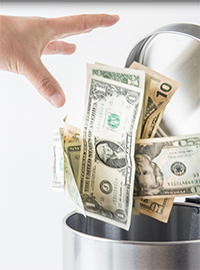The signs of economic decline are plentiful, but the central bank’s governors somehow keep overlooking them.
Wall Street investors and economic analysts have reacted eagerly to every conceivable signal that the Federal Reserve will soon declare inflation defeated and stop tightening the money supply. The Biden administration would like to see an interest rate cut to boost the president’s flagging re-election prospects, even though Joe Biden and his supporters continually claim that the economy is quite peachy as is. Apparently, the liberal idea of perfectibility is still alive.
Federal Reserve Chairman Jerome Powell, however, has been consistent in his message for months now: no change. Not now, and not soon.
Far from the economy being overheated, several signs point to serious economic struggles and further contraction.
The Fed argues that economic conditions are too good to merit a cut in interest rates and an end to its sales of securities, which tighten the money supply. The main thing we should be worried about is a resurgence of inflation, the Fed insists.
“I don’t think it’s likely that the committee will reach a level of confidence by the time of the March meeting” to justify a relaxation of the money-tightening, “but that’s to be seen,” the Wall Street Journal reported after Powell’s late-January news conference.
The Fed’s latest minutes, released last week, confirm the Federal Open Market Committee does not intend to start reducing interest rates in March. In addition, “a few participants noted that the process of balance sheet runoff could continue for some time even after the Committee begins to reduce the target range for the federal funds rate,” CNBC reported.
Tightening spurs recession worries
The Fed has been shrinking the money supply for nearly a year and a half — for the first time since 1949. There have been only four such contractions since the Fed was established in 1913, and all the others led to recessions.
By early January, the Fed had already completed more than $1 trillion of monetary tightening through selling of securities, reducing its assets from their near-$9 trillion peak in May 2022 to $7.6 trillion today. That process will continue.
In addition, bank reserves and overnight reverse repurchase agreements have both been declining since the middle of last year, signifying more money-tightening.
The markets know this is destructive. The Fed’s January interest rate decision hit markets hard on the day it was announced. “Stock indexes ended lower Wednesday, with the S&P 500 down 79.32 points, or 1.6%,” the Wall Street Journal reported. “The index, which on Monday closed at an all-time high, registered its biggest decline since September. Yields on the 10-year Treasury note declined 0.091 percentage point to close at 3.965% after New York Community Bancorp reported a loss and slashed its dividend, igniting new jitters about the health of regional lenders.”
The Fed did throw a bone to those hoping for lower interest rates, ending its guidance statement that it was more likely to raise rates than lower them. It has now adopted a neutral position that “the risks to achieving its goals of healthy labor markets and low inflation ‘are moving into better balance,’” the Journal reported. But that was a very small bone, as indicated by the markets’ abrupt nosedive.
Signs of trouble ahead
Far from the economy being overheated, several signs point to serious economic struggles and imminent further contraction.
U.S. job layoffs doubled in January. Food costs the average family a greater share of their income than at any time since the recession of 1990-1991. Retail sales collapsed in January. Manufacturing output decreased unexpectedly by 0.5% in that same month. Credit card debt hit another record high in the fourth quarter of 2023. Overall household debt likewise reached a record high, and delinquency rates increased. Home sales last year were the lowest in nearly three decades, and they are now down 6.2% from one year ago. Single-family housing starts fell in January. People cannot afford homes. Commercial real estate is in a historic slump.
I could go on — unlike the economy itself.
The Fed has supposedly been looking for signs that the economy is slowing down, as an indication that inflation will recede with the onset of economic pain. The signs of economic decline are plentiful, but the central bank’s governors somehow keep overlooking them. As a result, the Fed continues to claim that economic conditions are too good right now to merit a reversal of the money-tightening and that there is no need for artificial stimulation by the central bank.
Well, yes: We never need artificial stimulation of the economy. Likewise, we never need artificial strangulation of the economy. The latter, however, is exactly what the Fed has been giving us for well over a year.
If this ends well, it will be the first time that has ever happened. I would not bet on it.

